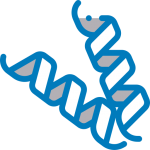
 UBE1 [6His-tagged]
UBE1 [6His-tagged]
61-0001-050
50 µg 100 µg
Brand
Ubiquigent
Description
The enzymes of the ubiquitylation pathway play a pivotal role in a number of cellular processes including regulated and targeted proteasomal degradation of substrate proteins. Three classes of enzymes are involved in the process of ubiquitylation; activating enzymes (E1s), conjugating enzymes (E2s) and protein ligases (E3s). UBE1 is a member of the E1 activating enzyme family and cloning of the human gene was first described by Handley et al. (1991). The UBE1 gene has been mapped to Xp11.3-p11.23 by highresolution fluorescence in situ hybridization (Takahashi et al., 1992). UBE1 ‘activates’ ubiquitin through catalysing a C-terminal ATP dependent adenylation of the protein which results in it forming a high-energy thioester bond with the sulfhydryl group of UBE1. UBE1 is monomeric and there are two active sites within the UBE1 protein allowing it to bind two ubiquitin moieties at a time, with a new ubiquitin forming an adenylate intermediate as the previous one is transferred to the thiol site (Jin et al., 2007; Zheng et al., 2009). Defects in UBE1 are known to cause spinal muscular atrophy X-linked type 2 (SMAX2) also known as X-linked lethal infantile spinal muscular atrophy, distal X-linked arthrogryposis multiplex congenita or X-linked arthrogryposis type 1 (AMCX1). Spinal muscular atrophy refers to a group of neuromuscular disorders characterized by degeneration of the anterior horn cells of the spinal cord, leading to symmetrical muscle weakness and atrophy. SMAX2 is a lethal infantile form presenting with hypotonia, areflexia, and multiple congenital contractures (Ramser et al., 2008).
Application
Reactivity



